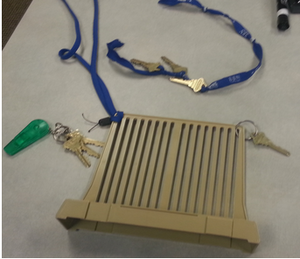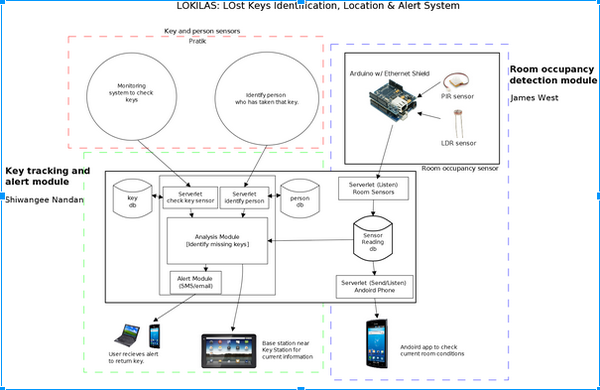Difference between revisions of "LOKILAS"
(→System Architecture) |
(→System Architecture) |
||
| Line 21: | Line 21: | ||
===System Architecture=== | ===System Architecture=== | ||
See Fig. 1 for a visual overview of the system data flow and overall architecture. | See Fig. 1 for a visual overview of the system data flow and overall architecture. | ||
| − | [[File:LOKILAS Architecture.png |thumb|center | | + | [[File:LOKILAS Architecture.png |thumb|center | 600px|ALt= Architecture| Figure 1: LOKILAS System Architecture Overview |
]] | ]] | ||
Revision as of 18:32, 21 November 2013
LOKILAS:LOst Key Identification, Localization and Alert System
Contents
Background
This project aims to solve a practical problem encountered by researchers in some of the Kno.e.sis labs regarding their shared lab keys. The keys in each lab are a shared resource to give the researchers access to shared facilities, such as conference rooms. Unfortunately, people who use the keys too often forget to return the keys in a timely manner and there is currently no system in place to track said keys. This can cause inconvenience and frustration for individuals who later need to use a facility but are unable to find the required key. Currently, the solution to this problem is to attach larger objects to a shared key, such as the key shown in Photo 1, so that the key cannot be forgotten in a pocket. While this solution may work, there is still an inconvenience to carrying the larger “keychain”. Project LOKILAS hopes to create an intuitive system for tracking and recovering the shared keys.
Project Specification
The proposed system would be required to track the shared keys in a lab, identify anyone who takes one of the keys, and alert the person who took the key to return it after they are done with the key. Various sensors monitor the keys currently at a base station in a lab, identify any person who approaches the base station, and report the status of the rooms tied to each key. The status of all monitored items is then reported by the sensors to a server where the information can be combined and processed. If a certain amount of time has passed without the key being used or returned, an alert will be sent to the person who originally took the key from the base station through either SMS or email. Finally, the status of all keys and rooms may be monitored through a pair of Android applications.
This project is based on the internet of things concept. Keys, people, and rooms are each identified and networked to provide a more intelligent tracking system.
Assumptions:
Everyone turns off the lights when they are done using the room.
Only the key that was taken will be used to access the associated room. Meaning that if a different key is used, the system may incorrectly believe that the key is still in use, causing the system to continue waiting instead of sending an alert (assuming the key is still missing).
A key that was taken from the base station does not leave the proximity of the person who took the key before it is returned to the base station.
Each key and person can be identified relatively quickly at the base station so as not to slow the person down.
Approach
System Architecture
See Fig. 1 for a visual overview of the system data flow and overall architecture.

